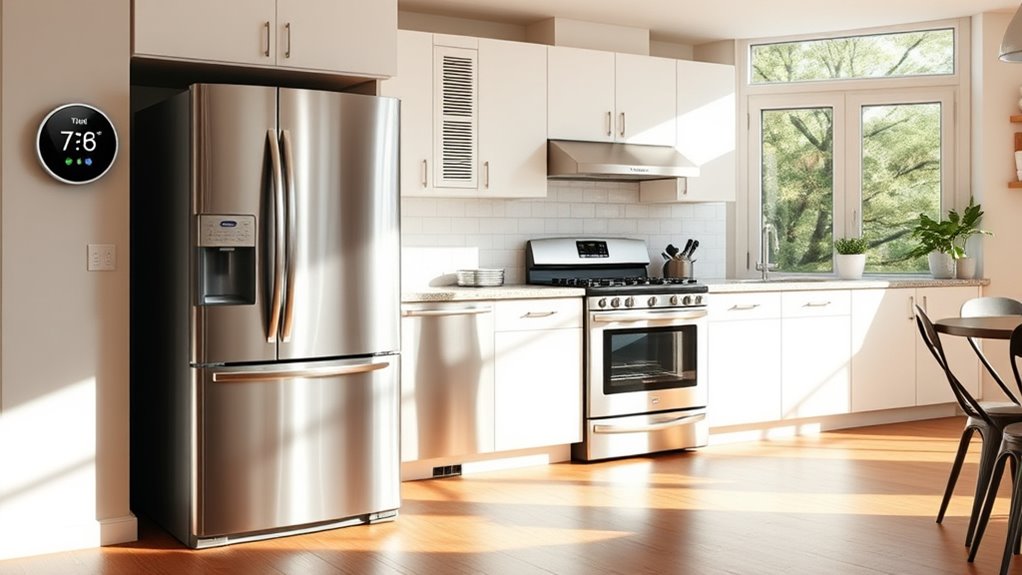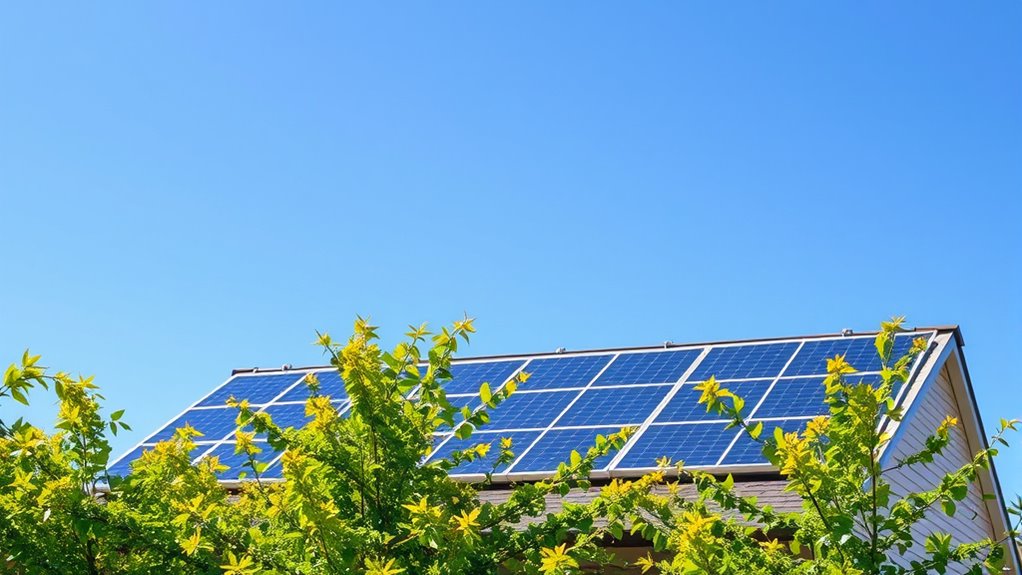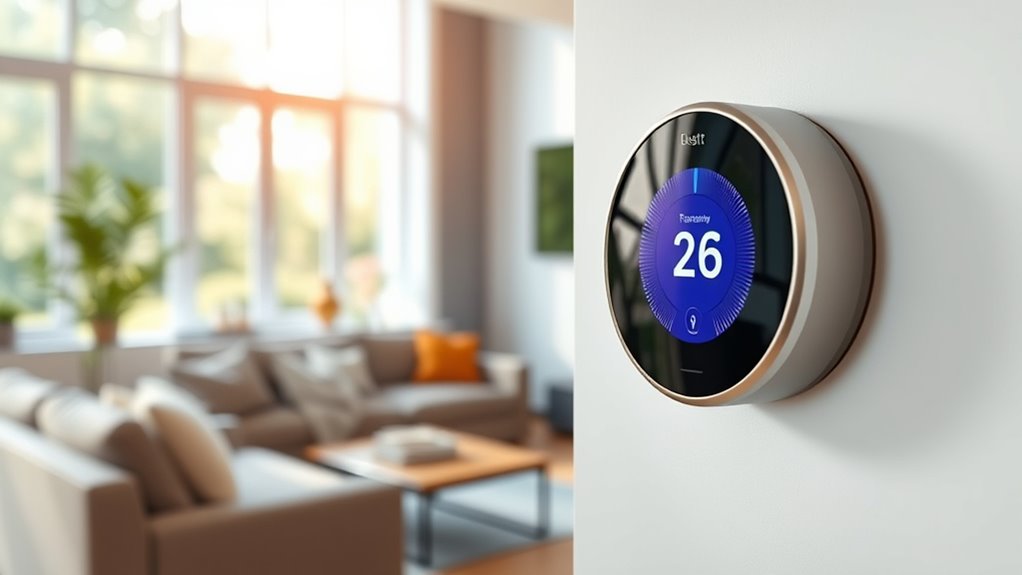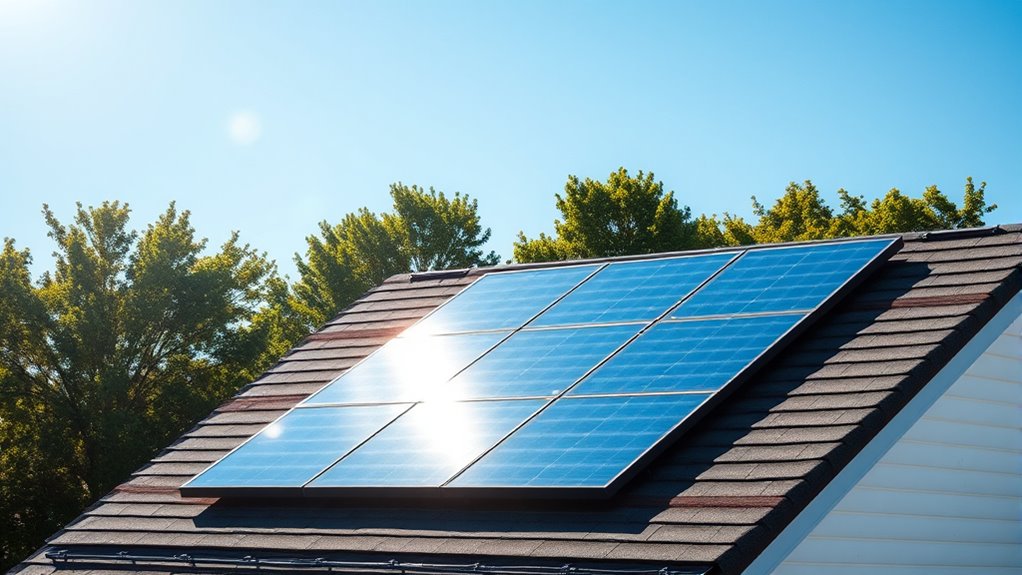Sealing air leaks around your doors, windows, and ducts can instantly cut your home’s energy waste by up to 20%. It’s a simple, cost-effective step that improves insulation and reduces heat loss, directly lowering your carbon footprint. Pair this with a home energy audit to identify other efficiency gaps. Small changes like this can deliver big environmental benefits, and there’s more tips that can make your home even greener if you keep exploring.
Key Takeaways
- Conduct a home energy audit to identify and seal leaks, improving insulation and reducing heat loss.
- Upgrade to energy-efficient appliances and install smart thermostats to optimize energy use and lower emissions.
- Transition to renewable energy sources like solar or wind to directly power your home with clean energy.
- Adopt daily habits such as turning off unused lights and unplugging devices to prevent phantom energy waste.
- Incorporate natural and sustainable materials in your home improvements for enhanced insulation and eco-friendliness.
Conduct a Home Energy Audit

Conducting a home energy audit is a crucial step in identifying where your home wastes energy. It helps you improve energy efficiency and reduce your carbon footprint. During the audit, professionals can perform leak detection, thermal imaging, and inspections to spot areas of energy waste. Many utility companies offer low-cost or free audits, making it easier to pinpoint problem spots. The results provide tailored recommendations, such as insulation upgrades or installing energy-efficient systems, which can notably reduce your energy bills and greenhouse gas emissions. Regularly scheduling these audits ensures your home stays as eco-friendly as possible, tracking improvements over time. By taking this step, you not only save money but also contribute to a healthier planet.
Seal Air Leaks and Improve Insulation

Sealing air leaks and improving insulation are among the most effective ways to cut your home’s energy waste and reduce its carbon footprint. Air leaks around doors, windows, and ducts can cause significant heat loss, accounting for up to 20% of energy waste if not sealed properly. By sealing these leaks, you enhance energy efficiency and indoor climate control, making your home more comfortable year-round. Upgrading insulation in walls, attics, and floors also boosts thermal retention, reducing the need for heating and cooling. These insulation upgrades not only improve home comfort but also lower emissions by decreasing energy consumption. Regularly inspecting and sealing leaks, combined with effective insulation, ensures better heat retention and a greener, more efficient home. Incorporating natural materials like wool or cellulose in insulation can further improve sustainability and energy savings. Additionally, understanding Gold IRA options can provide alternative strategies for securing your financial future while maintaining eco-friendly investments. Properly maintaining your insulation and sealing efforts also prevent drafts, further enhancing your home’s energy efficiency and environmental impact. Addressing building envelope issues can lead to substantial long-term savings and environmental benefits.
Upgrade to Energy-Efficient Appliances and HVAC Systems

Upgrading to energy-efficient appliances and HVAC systems can considerably lower your home’s carbon footprint while saving you money. Smart thermostats help optimize energy use, making your systems more efficient and reducing waste. Choosing high-efficiency equipment also often comes with rebates, making the switch more affordable and worthwhile. Incorporating automation technologies can further enhance energy savings by adjusting settings based on your habits and preferences. Additionally, selecting performance upgrades such as upgraded insulation or window treatments can further improve overall energy efficiency. Modern heat pumps designed with quieter operation in mind can also reduce noise pollution, contributing to a more comfortable living environment. Being aware of regional resources can help you access local incentives and expert guidance for making these upgrades.
Smart Thermostat Benefits
Installing a smart thermostat is one of the easiest ways to make your home more energy-efficient. It can help you reduce energy use by automatically adjusting your home heating and cooling based on your schedule, which cuts down on unnecessary energy waste. This not only lowers your energy bills but also decreases carbon emissions, helping to reduce your home’s environmental impact. By optimizing your HVAC system’s operation during peak and off-peak hours, a smart thermostat minimizes greenhouse gases released into the atmosphere. Proper programming and learning features prevent waste and extend the lifespan of your heating and cooling systems. Additionally, integrating a smart thermostat with other energy-efficient appliances can amplify your home’s sustainability efforts. Incorporating high-efficiency HVAC systems further enhances the effectiveness of your energy-saving strategies. Choosing the right smart thermostat features can maximize your energy savings and environmental benefits. Making conscious choices about your home’s energy consumption can lead to significant reductions in your overall carbon footprint. For example, selecting a device with advanced learning capabilities can help adapt your system more precisely to your needs. Shifting to a smart thermostat is a simple yet effective step toward a more sustainable home, making a meaningful difference in your carbon footprint.
Choosing High-Efficiency Equipment
Choosing high-efficiency appliances and HVAC systems is one of the most effective ways to lower your home’s energy use and carbon footprint. Upgrading to Energy Star-rated appliances and modern heat pumps can cut energy consumption by 10-30%, reducing carbon emissions markedly. Replacing outdated appliances like refrigerators or washers with energy-efficient models saves around 500 kWh annually, lowering emissions by about 0.3 tons of CO₂ per device. Incorporating energy-efficient technology into your home can further enhance overall savings and sustainability. Installing self-watering plant pots can help reduce water usage and promote healthier indoor plants, contributing to a more eco-friendly household. Additionally, understanding Hackathons can be a great way to discover innovative solutions and technologies that support energy efficiency and sustainability goals. Energy-efficient HVAC systems, such as ductless mini-split heat pumps, often qualify for rebates and incentives, offsetting their costs. These upgrades not only benefit the environment but also reduce utility bills, offering long-term savings. Incorporating solar panels with battery storage into your energy plan can further maximize efficiency and independence from the grid. Consider this table to understand the impact:
| Appliance Type | Annual Savings | Emissions Reduced |
|---|---|---|
| Refrigerator | 500 kWh / year | 0.3 tons CO₂ |
| Heat Pumps | Up to 50% less energy | Considerably reduction |
| Incentives | Rebates available | Cost savings |
| Overall Impact | Lower utility bills | Sustainable practices |
Switch to a Renewable Energy Provider

Have you considered switching to a renewable energy provider to cut your home’s carbon footprint? Many utility companies now offer green energy plans that let you support clean energy sources like wind, solar, and hydro without installing your own systems. By choosing a renewable energy provider, you can substantially reduce household emissions and lower your overall carbon footprint. This simple change encourages the use of sustainable infrastructure and promotes energy-efficient practices. Additionally, understanding nutritional advantages of green juice can inspire broader environmental choices that benefit health and sustainability. Supporting renewable energy helps accelerate the shift away from fossil fuels and contributes to a cleaner environment. Incorporating energy efficiency measures into your home can further enhance your eco-friendly efforts, reducing energy consumption and costs. Smart energy solutions, such as smart thermostats and LED lighting, can make a significant difference in your energy usage. AI security solutions are increasingly employed by organizations to protect critical infrastructure, ensuring that energy systems remain resilient against cyber threats. Making this switch is a straightforward way to make your home more eco-friendly while benefiting from the growth of sustainable energy solutions.
Install a Smart Thermostat for Better Climate Control

Installing a smart thermostat helps you save energy and cut costs by optimizing your heating and cooling schedules. It learns your routines and allows remote control, preventing unnecessary energy use. Making this simple upgrade can substantially lower your home’s carbon footprint and save you money each year.
Smart Thermostat Benefits
A smart thermostat can substantially improve your home’s climate control while helping reduce energy consumption. By learning your schedule and preferences, it optimizes temperature control to reduce energy use without sacrificing home comfort. This leads to significant energy savings—up to 12% annually on heating and cooling bills—while cutting your carbon footprint. You can remotely adjust your thermostat via smartphone, preventing unnecessary energy waste when you’re away. Many models are compatible with renewable energy systems, boosting your home’s sustainability and decreasing reliance on fossil fuels. Adopting a smart thermostat not only enhances energy efficiency but also supports efforts to combat climate change. It’s a simple, effective way to make your home more eco-friendly and aligned with a smart home lifestyle.
Energy Savings Optimization
By upgrading to a smart thermostat, you can considerably optimize your home’s climate control and reduce energy waste. This device learns your household patterns and adjusts temperatures automatically, leading to significant energy savings and improved energy efficiency. With features like remote control and scheduling, a smart thermostat prevents unnecessary heating or cooling when you’re away, helping to reduce carbon footprint and greenhouse gases. Studies show that using a smart thermostat can lower home greenhouse gas emissions by about 1 ton of CO₂ annually. Over time, it cuts home energy use and reduces energy costs, making your home not only greener but also more economical. This simple change makes a real difference in lowering your carbon emissions while maintaining comfortable climate control.
Use Solar Power to Generate Clean Energy

Switching to solar power allows you to generate clean energy right at home, substantially cutting your carbon footprint. By installing solar panels, you can offset the electricity produced from fossil fuels, which account for about 60% of household emissions. Visualize a system of sleek solar energy systems on your roof, harnessing sunlight to produce power. Imagine reducing greenhouse gases and shifting to renewable energy sources that promote energy efficiency. With costs dropping about 80% over the past decade, solar panels are more accessible, especially with regional incentives covering up to half the expense. Think of long-term savings on your electricity bills and increasing your property value. Using solar power is a smart way to reduce emissions and make your home more sustainable.
Adopt Daily Habits to Reduce Energy Waste

Implementing simple daily habits can substantially cut your home’s energy waste and lower your carbon footprint. Start by turning off lights when leaving a room—this small act can save 10-15% of household energy. Switch to energy-efficient LED bulbs to reduce lighting energy use by up to 75%. Unplug electronic devices and chargers when not in use to prevent phantom energy draw, which accounts for 5-10% of your home energy use. Washing clothes in cold water instead of hot can lower laundry energy consumption by over 70%. Manage your thermostat wisely by lowering winter temperatures and raising summer settings, reducing heating and cooling energy waste by 10-20%. These sustainable choices help you reduce your carbon footprint and make your home more energy-efficient every day.
Frequently Asked Questions
How Can We Reduce Our Carbon Footprint at Home?
You can reduce your home’s carbon footprint by starting with a home energy audit to spot wasteful areas. Upgrading to energy-efficient appliances and LED bulbs helps cut energy use, while sealing air leaks and improving insulation lower heating and cooling needs. Consider installing solar panels or switching to green energy plans. Simple habits like turning off unused electronics and washing clothes in cold water also make a big difference.
What Is One Way Your Household Could Reduce Its Carbon Footprint?
Imagine your home as a garden, and your choices are the seeds you plant. To reduce your household’s carbon footprint, consider switching to a renewable energy plan or installing solar panels. This simple step transforms your energy source into sunlight and wind, washing away pollution like a invigorating rain. It’s a powerful move that brightens your home’s future while helping the planet breathe easier.
What Changes Can You Make to Reduce Your Carbon Footprint?
To reduce your carbon footprint, start by upgrading to energy-efficient appliances and LED lighting. Seal air leaks and improve insulation to cut down on heating and cooling needs. Consider installing a heat pump for climate control or switching to renewable energy sources like solar panels. Additionally, getting a home energy audit can identify further inefficiencies, helping you make targeted improvements that substantially lower your household’s emissions.
How to Reduce Housing Shelter Footprint?
To reduce your housing shelter footprint, start by upgrading to energy-efficient appliances and better insulation, which can cut emissions considerably. Consider installing solar panels to harness renewable energy and reduce reliance on fossil fuels. Seal leaks and improve home airtightness to lower heating and cooling energy use. Choosing denser housing options like condos or townhouses also helps, as it spreads out emissions and lessens your overall impact.
Conclusion
Think of your home as a garden—small changes can help it flourish while reducing your carbon footprint. By taking simple steps like sealing leaks, upgrading appliances, and embracing renewable energy, you become the gardener tending to a healthier planet. Just one easy switch can ripple outward, making a big impact. So, start today, nurture your home’s energy efficiency, and watch your efforts bloom into a greener, cleaner future for all.









